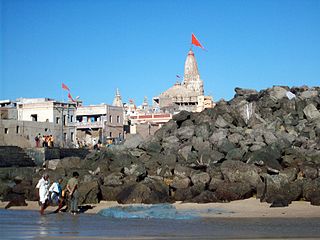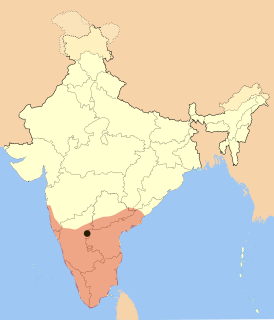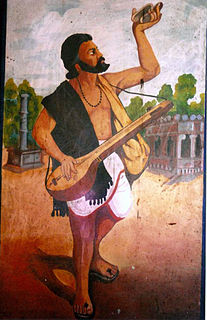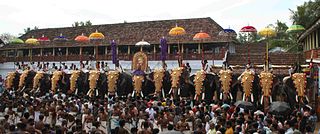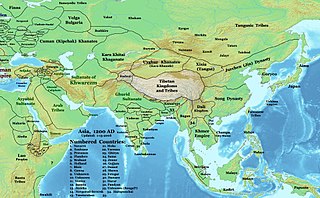Mohanatarangini (River of delight) is the first work of Kanakadasa (1509–1609), a prominent literary figure in Kannada literature whose works are mostly in the Sangatya (composition meant to be sung to the accompaniment of a musical instrument), [1] Shatpadi (Six line poems) and Shataka (hundred verse) metres. It has been estimated that he may have been around 35 years of age when he wrote this work.

Kannada is a Dravidian language spoken predominantly by Kannada people in India, mainly in the state of Karnataka, and by significant linguistic minorities in the states of Andhra Pradesh, Tamil Nadu, Telangana, Kerala and abroad. The language has roughly 43.7 million native speakers, who are called Kannadigas. Kannada is also spoken as a second and third language by over 12.9 million non-Kannada speakers living in Karnataka, which adds up to 56.6 million speakers. It is one of the scheduled languages of India and the official and administrative language of the state of Karnataka.
Contents
This work, which is the biggest of Kanakadasa's compositions, contains 42 chapters with 2800 verses in the Sangatya metre. [2] It contains various pauranika stories about suras, asuras and Krishna which the author narrates to his wife. The work has been inspired by mythological stories from the Bhagavata, the Mahabharata and various other puranas.

The word Puranas literally means "ancient, old", and it is a vast genre of Indian literature about a wide range of topics, particularly myths, legends and other traditional lore. Composed primarily in Sanskrit, but also in regional languages, several of these texts are named after major Hindu deities such as Vishnu, Shiva and Devi. The Puranas genre of literature is found in both Hinduism and Jainism.

Shree Krishna or simply Krishna is a major deity in Hinduism. He is worshipped as the eighth avatar of the god Vishnu and also as the supreme God in his own right. He is the god of compassion, tenderness, and love in Hinduism, and is one of the most popular and widely revered among Indian divinities. Krishna's birthday is celebrated every year by Hindus on Janmashtami according to the lunisolar Hindu calendar, which falls in late August or early September of the Gregorian calendar.
In Hinduism a Bhagavata, is a devotee, worshipper or follower of Bhagavanta namely God in his personal aspect. The form of worship is called bhakti which has the meaning of 'adoration'. In Sanskrit language 'Bhaga' stands for desire, 'antha' stands for the end. Hence Bhagavanta or Bhagavan means 'the one beyond desire or rebirth', whereas Bhagavata indicates a worshiper of this purified and persistent entity. It also refers to a tradition devoted to worship of Krishna, later assimilated into the concept of Narayana where Krishna is conceived as svayam bhagavan. According to some historical scholars, worship of Krishna emerged in the 1st century BC. However, Vaishnava traditionalists place it in the 4th century BC. Despite relative silence of the earlier Vedic sources, the features of Bhagavatism and principles of monotheism of Bhagavata school unfolding described in the Bhagavad Gita as viewed as an example of the belief that Vasudeva-Krishna is not an avatar of the Vedic Vishnu, but is the Supreme.
It is believed that Kanakadasa wrote this work when he lost his beloved wife. He seems to recount his personal experiences in fond remembrance of his wife. There is a close relationship between music and Sangatya poems in his work. This is a Sringara Rasa based book spanning over three generations. It is a story of Manmatha (the god of love), his parents Krishna and Rukmini, Pradumya (Rukmini's son), Rathi (Manmatha's wife), Aniruddha and Ushe. This story ends in defeat of demon Banasura and marriage of Ushe and Aniruddha using a presentation similar to sukumara style (a style of poetics elaborated by Kuntaka, a Sanskrit grammarian in his Vakroktijivita ). [3]

Sringara is one of the nine rasas, usually translated as erotic love, romantic love, or as attraction or beauty. Rasa means "flavour", and the theory of rasa is the primary concept behind classical Indian arts including theatre, music, dance, poetry, and sculpture. Much of the content of traditional Indian arts revolves around the relationship between a man and a woman. The primary emotion thus generated is Sringara. The romantic relationship between lover and beloved is a metaphor for the relationship between the individual and the divine.

Rukmini is the principal wife and queen of the God Krishna, the prince of Dwaraka. Krishna heroically kidnapped her and eloped with her to prevent an unwanted marriage at her request and saved her from evil Shishupala. Rukmini is the first and most prominent queen of Krishna. Rukmini is also considered an avatar of Lakshmi, the Goddess of fortune.
Kuntaka Sanskrit: कुन्तक was a Kashmiri Sanskrit poetician and literary theorist who is remembered for his work Vakroktijīvitam in which he postulates the Vakrokti Siddhānta or theory of Oblique Expression, which he considers as the hallmark of all creative literature. He lived roughly 950–1050, between Anandavardhana in the ninth century and Abhinavagupta in the tenth century and was a rough contemporary of Dhananjaya and Rajasekhara.
